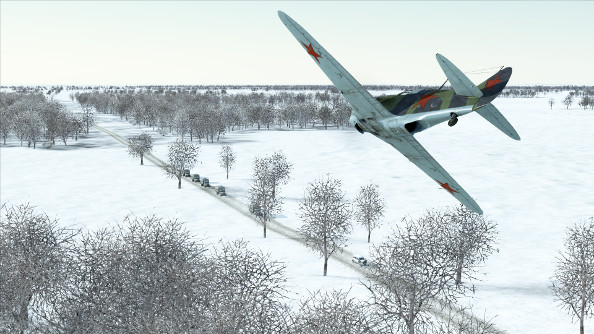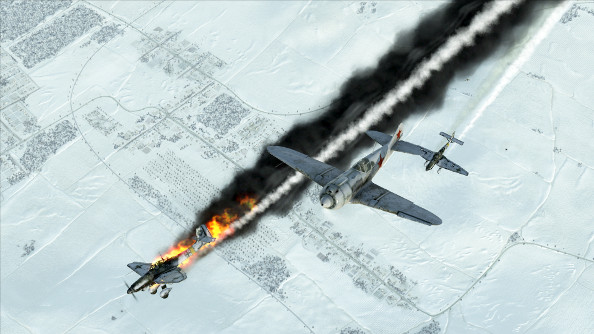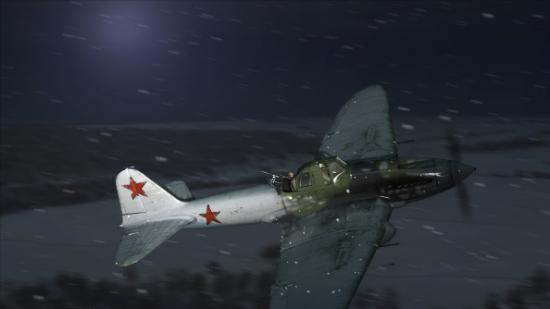IL-2 Sturmovik ruled the World War Two flight-sim roost like few games ever have. Not only did it expose sim audiences to the often-overlooked Eastern Front air war, but it proved to be a gift that kept on giving: its lengthy series of expansions covered everything from early jet-fighter combat to the Pacific air war.
But from such a height came a similarly precipitous fall with the with the disastrous (and awkwardly-named) IL-2 Sturmovik: Cliffs of Dover, an ill-fated take on the Battle of Britain that led to the departure of series creator Oleg Maddox and a terrible, buggy release that left many fans feeling burned.
Now, with IL-2: Battle of Stalingrad and a new development team, 1C are trying to get the king of WW2 aviation back in the air.
There is one major lesson 1C learned from Cliffs of Dover, said producer Albert Zhiltsov. “Do not try to sell promises. Try to sell the product you already have.”
As a result, Battle of Stalingrad has followed a much more open, and much humbler, course of development. 1C have tried to maximize their transparency with the game and explained their thinking at each stage of the project. It’s a far cry from the black-box development that was Cliffs of Dover, with its ever-growing list of promises to a faithful fan base.
“Last November we opened Early Access after just 6 months of development,” Zhiltsov said. “So we don’t describe… the amazing project we plan to do. We just try to show progress.”
While Maddox may have moved on from 1C, Battle of Stalingrad is in some very capable hands thanks to the involvement of 777 Studios, the developers behind the highly-regarded Rise of Flight series of World War One combat sims.
While IL-2: Battle of Stalingrad might be returning to the eastern front, it’s a much bigger and more ambitious game than the original Sturmovik. It will feature 10 aircraft ranging from single-seat fighters like the BF-109 to ground-attack aircraft like the IL-2, all the way up to heavier bombers like the Soviet Pe-2 and German He-111. Purchasers of the premium edition will also get the FW-190 and La-5, two of war’s best fighters that were deployed prior to the Battle of Stalingrad, though neither actually saw action there.
War along the Volga
The aircraft will do battle over 49,000 square miles of the Stalingrad front, in a sprawling campaign that starts with the opening of Operation Uranus and Soviet encirclement of the German army to Sixth Army’s final surrender at Stalingrad.
The campaign has five chapters, each corresponding to a stage of the campaign. It’s not a quite a fully dynamic campaign, since the historical trajectory is inevitable: the Germans will be cut-off in the Stalingrad pocket, they will try to resupply by air and fail, and ultimately they will lose the battle. This is just as well and something of a relief: dynamic campaigns in flight sim always had a tendency to get a bit silly in how a player’s performance could alter the outcome of a war. Sorry, Manfred, but no matter how many hostiles you bag, Germany is going down.
However, even if the campaign isn’t dynamic, it is randomized. Players will download missions from the Battle of Stalingrad servers so that the campaign plays out slightly differently every time. It also means that playing the campaign will require the game connect to online servers.
I asked executive producer Jason Williams, from 777, about this feature and what parts of the game would be playable offline. He explained, “The Campaign mission generator generates the missions for you server-side and includes randomized, dynamic events so no two missions play the exact same which increased long-term re-playability.
“Certain parts of [Battle of Stalingrad] will be able to played offline as in our earlier title Rise of Flight such as the Quick Mission Builder we mentioned and custom missions,” he continued. “We try to minimize the necessary connection wherever we can, but it has worked well for us in our previous title. “
This sounds like an interesting feature, although I tend toward skepticism about the long-term costs of such an approach. But what does sound cool is the mission variety in IL-2 and the new possibilities offered by improved technology. The Eastern Front tended to be about low-altitude air-support missions. Tank-killing and attacks on fixed positions were a big part of what Russian and German bombers did, and fighters flew in support of those missions. But now, with more powerful technology, players will actually be able to see and intervene in the Battle of Stalingrad unfolding beneath them.

“[We even have] small details, like tanks trying to attack a position and anti-tank guns trying to kill them,” Zhiltsov said. “If you’re playing the German side, your mission will be to destroy that antitank guns in 20 minutes before they kill all the tanks.”
The Russian side, meanwhile, might be sent in to make bombing runs on the tank assault, or to try and chase off the German bombers before they can do too much damage to the anti-tank gunners. But with an entire ground battle taking place below, Battle of Stalingrad should feel like something unprecedented in terms of realism and scale.
With scores of AI-controlled aircraft performing missions of their own alongside the player, there is a lot of potential for random encounters just traveling to and from a mission, as escort fighters get pulled into someone else’s furball or a flight of bombers on a return to base spot a position being overrun.
More intelligence, less artifice
That AI is what Zhiltsov and 1C are proudest of. At its most basic level, just in the way it flies its aircraft, the AI is behaving completely differently from the way most flight sim AI have worked historically, said Zhiltsov.
“Usually, in the sim industry, the AI is based on the idea of the AI cheating. Like, they have a simple flight model. No physics. And you struggle against them because they are breaking the rules.”
Battle of Stalingrad won’t have any such Potemkin pilots. Zhiltsov likens the new AI to that of a drone aircraft.
“Military drones [are basically] AI. They are things that can fly [with] real physics laws. So we try to grab knowledge from this idea and we create our own… let’s call him a robot,” Zhiltsov explained. “He’s touching controls, he’s flying exactly like players. Sometimes he can make mistakes like a human. Like go in stall or spin.”
In addition to that base-layer of AI piloting, the AI also has two other levels of thinking. The first is tactically, at the flight or squadron level. Think of it as overall situational awareness. Which wingmen are in trouble, who has the altitude advantage and where is the sun relative to the combat. This will hopefully make it so that aircraft don’t just fight as a collection of individuals, but actually work together.

The top layer is more strategic, though it’s really more about mission-awareness. It controls how the AI will go about trying to fulfill its mission without getting everyone killed. So if a flight of bombers has a critical mission to knock out a bridge, they are going to stick together as long as possible and try and hit that target, even if they are taking losses. But their fighter escorts will spot incoming enemy aircraft and aggressively engage, trying to create a huge dogfight that the bombers can slip past. Likewise, if you’re flying home from a mission and some enemy fighters spot you, they’ll judge whether or not you’re worth engaging based on their own circumstances and the value they perceive in shooting you down.
There are a lot of really exciting things about this new IL-2. Zhiltsov was describing the German air bridge supply operation to try and keep 6th Army alive, and how pilots on both sides contended with terrible visibility and hellish weather as they fought to either save or starve the Germans. If you are particularly enjoying one segment of the campaign, you can even stretch it longer and put off moving to the next chapter.
But above all, Battle of Stalingrad sounds like it’s focused on some core, achievable objectives. As 777’s Jason Williams said, “We have a history on Rise of Flight of making things that work. And if they don’t work, we address it.
“We stick to our schedule, we stick to our plan. We don’t let mission creep affect our schedule. Our goal is to have the game work on Day One.”
After the painful disappointments of Cliffs of Dover, hopefully 1C’s return to the air war will live up to both the IL-2 name and the Rise of Flight legacy. We’ll get our answer when the game ships this September.
